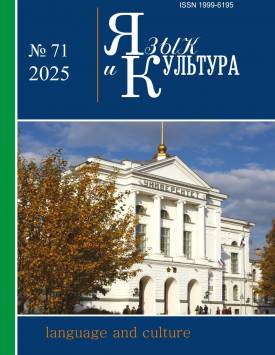Zoonymic pragmaphytonyms and their functions
The purpose of the article is to determine the the semantic functions of tomato breeding nomenclature containing zoolexics (Del'fin/Dolphin, Sibirskij medved' / Siberian bear, Utinyj nos / Duck nose, Animal heart). The study uses the author's terms pragmaphytonym, which is understood as a pragmatic type of phytonym, denoting proper names for varieties, plant hybrids - the results of breeding work in the agricultural sphere, and tomatonym - as one of its types. Such properties not only characterize the object of the nomination as a product, but also reflect the purpose of naming - to promote it on the market, which gives reason to classify them as commercial (advertising) names. The main source of the research material is the State Register of Varieties and hybrids of agricultural plants approved for use in 1943-2024 (3,715 names, see gossortrf.ru), supplemented by the results of a free search for tomato names on various horticultural seed websites and forums in Russia (2,525 names), a total of6,240. Among them, 545 zootomatonyms were identified, which is more than 9% of the identified varietal names of tomatoes. Onyms of this type are represented by six groups, the largest of which are 3, including: 1) common names of animals (Amurskij tigr / Amur tiger, Zheltyj bizon / Yellow Bison, Kaban / Wild Boar, Rozovyj flamingo / Pink flamingo, Krasnaya lisichka / Red Fox) - 317 / 59%; 2) their traditional proper names (Patrikeevna, Mishka Kosolapyj, Pegasus, Barbos, Burenka, Tigris) - 41 / 8%; 3) names of animal body parts (Serdce kenguru / Kangaroo heart, Lisichkin hvostik / Fox tail, Kogot' medvedya / Bear's Claw , Zuby drakona / Dragon Teeth) - 149 / 28%. In total, 140 animal names and 24 somatisms are involved in the formation of zoophoric tomatonyms. The most sought-after image in the nomination of tomato varieties and hybrids is the bull image: Babushka byka / Bull's Grandmother, Bychok rozovyj / Pink Bull, Bychij glaz / Bull's Eye, Bych'e serdce / Bull's Heart, Bych'ya sila / Bull's Strength, 55 in total. This group of "bull" names includes names derived from semantically similar words bugai, ox, buffalo, buffalo, bison, taurus, yak, increasing it to 82 onyms. Next in frequency of animal forms are: bear (Chernyj medved' / Black bear, Medvezhonok / Little Bear, Medvezhij sled / Bear trail, Toptygin, total - 28), tiger (Balkanskij tigr / Balkan tiger, Temnyj tigr / Dark tiger, Tigrovyj koktejl' / Tiger cocktail, total - 22), fox (Glaz lisy / Fox's Eye, Lisichkina tajna / Fox's secret, Patrikeevna) and wild boar (Kabanyaka / Huge Boar, Kaban krasno-korichnevyj / Red-brown wild boar), both have 13 onyms. The most frequent somatism is the heart, it is part of 56 names of this group: Medvezh'e serdce / Bear's heart, Lebyazh'e serdce / Swan's heart, Serdce borova / Hog's heart, Serdce zubra / Bison's heart, Serdce krasnogo drakona / Red dragon's heart, Starinnoe bych'e serdce iz Minusinska / Ancient bull's heart from Minusinsk, etc.). The second most popular is the word comb. Greben' ognennyj ohra / Fiery ocher comb, Zolotoj grebeshok / Golden comb, total - 25. Next in frequency are paw (Lapa kenguru / Kangaroo paw, Lyubimye lapki / Favorite paws, total -15), ear (Zayach'i ushi / Rabbit ears, Ushki kabanchika / Boar ears, Oslinye ushi krasnye / Donkey ears red, total - 12), eye (Voronij glaz / Crow's eye, Koshachij glaz / Cat's eye, Glaz drakona / Dragon's Eye, Zagorskoe volov'e oko / Zagorsky cow's eye -total 10), nose (Volov'i ushi s nosikom / Cow ears with a nose, Liskin nos / Fox's nose, 8 in total). This vegetable crop has a certain variety of characteristics, some of which (bush height, leaf shape, yield, drought resistance, cold resistance, disease resistance) characterize the plant itself, some - its vegetables (size, shape, color / coloring, taste, purpose, shelf life, transportability, etc.). The analysis showed that Zoophoric names can express various characteristics of cultivars, but mainly visually observable signs of fruits, with their size and shape being the most regularly expressed. The first is expressed through zoonyms (the names of large animals are used to denote large-fruited tomatoes, small ones are small-fruited), the second is through somatic vocabulary. Only a small part of zootomatonyms can be called uninformative (conditionally symbolic) ones. Such names primarily perform their direct function - nominative (nominative-differentiating). A comparison of the propriatives with the common phyto-lexicon showed a significantly wider list of zooforms with a smaller set of features expressed by such names in the case of onyms, and also proved the difference in the dominant images in the groups: for tomatonyms it is a bull, and for appellatives it is a snake / snake. The initial analysis of the names in terms of origin revealed the presence of a similar group in different languages (Mammoth German gold, Huevo Toro Del Rio Guadarrama, Cuor di bue, Italian Stallion), which does not negate the national specificity of the animal images involved in the nomination. So, among the Russian names, there was not a single "snake" onym characteristic of foreign naming: Cobra (France), Snakebite (Australia - USA), Black mamba, Spud Viper, Red Viper, Funky Viper (USA). The study allows us to conclude that zoophoric names show the interaction of the plant code of a traditional culture with its animal code, therefore metaphorical transfer should be attributed to one of the most important nomination mechanisms in the breeding nomenclature. The authors declare no conflicts of interests.
Keywords
onomatology, pragmaphytonyms, zoonymic names, tomatonyms, semantic functionsAuthors
| Name | Organization | |
| Li Tong | National Research Tomsk State University | tongli2020@yandex.ru |
| Starikova Galina N. | National Research Tomsk State University | gstarikova@yandex.ru |
References

Zoonymic pragmaphytonyms and their functions | Yazyk i Kultura – Language and Culture. 2025. № 71. DOI: 10.17223/19996195/71/2
